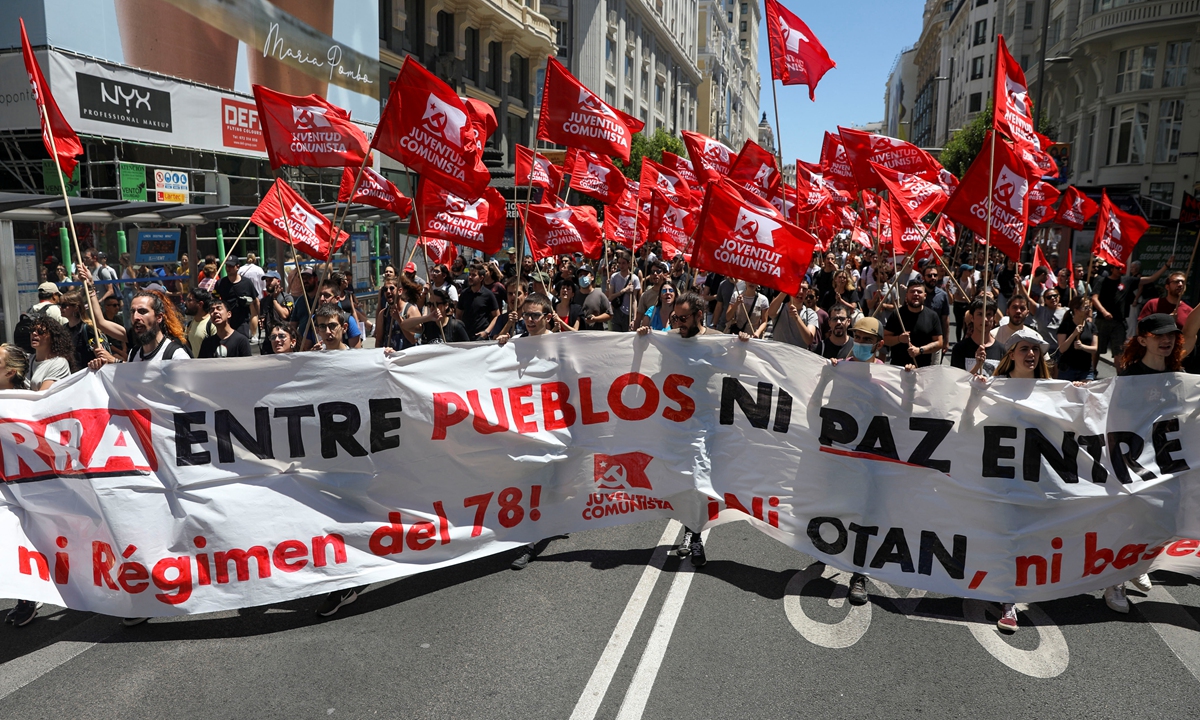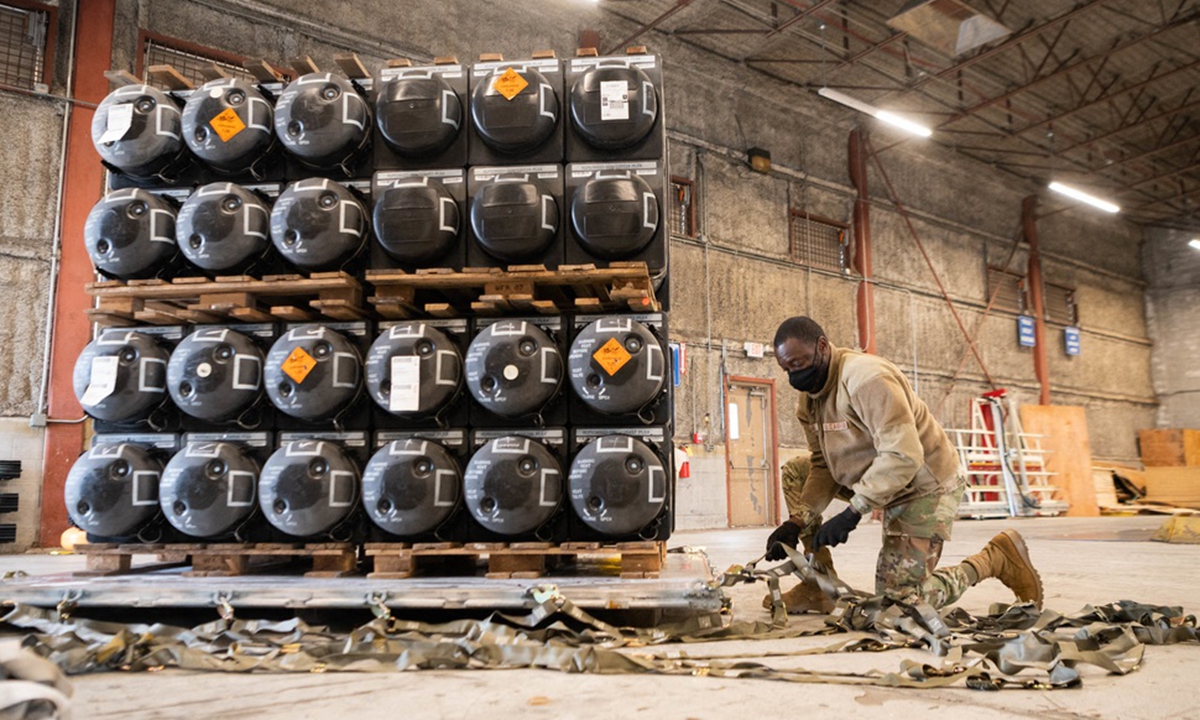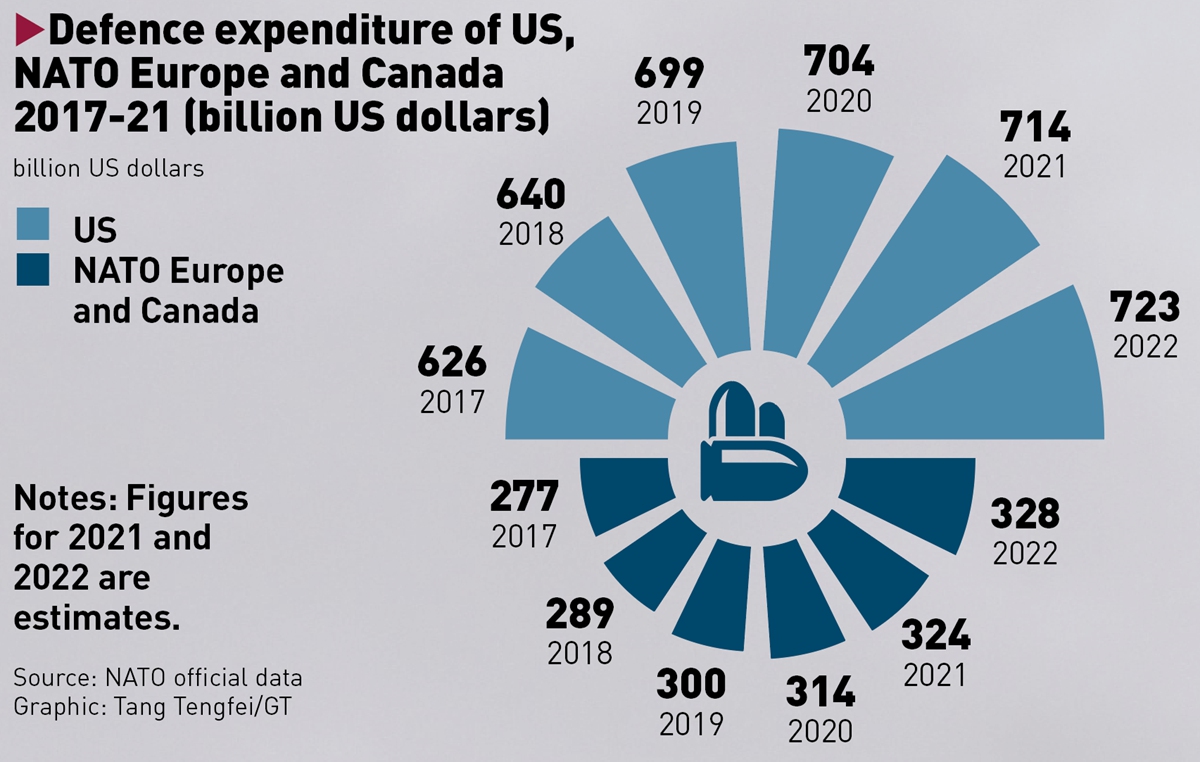
Demonstrators take part in an anti-NATO protest ahead of the NATO summit in Madrid, Spain, June 26, 2022. Photo: IC
Editor's Note:Amid the still ongoing Russia-Ukraine military conflict, NATO, which has been adding fuel to the conflict, started a three-day summit in Madrid, Spain, from June 28 to 30. The NATO alliance works to increase pressure on Russia over its conflict with Ukraine while underscoring their continued concerns about China. For the first time in history, leaders from four Asia-Pacific countries - namely Australia, Japan, South Korea, and New Zealand - were also invited to attend the NATO summit. The militant group which has already made troubles for Europe is now trying to create its own Asia-Pacific chapter to interfere in Asia. How did the organization come about? How was it born from the Cold War mentality and gradually became a poisoner of world peace? Why is this military alliance extending its "dark hand" to Asia? The Global Times will publish a series of four articles on how NATO is expanding. This is the second installment.
In April 1999, when NATO celebrated its 50th anniversary, it completed its first round of eastward expansion after the Cold War. The Global Times reporter was then stationed in Brussels, where NATO's headquarters are based, and witnessed the flag-raising ceremony to mark Poland, the Czech Republic, and Hungary joining NATO.
Back then, some media outlets said NATO had formally set in motion the return of Central and Eastern Europe. At that time, NATO had also pressed the button for the massive bombing of Yugoslavia. The bombing, code-named "Operation Allied Forces," which began on March 24, 1999, lasted 78 days, killing more than 2,500 innocent civilians and displacing more than 1 million.
This was the first time that NATO deployed forces without the approval of the UN Security Council and it targeted a sovereign country that had posed no threat to NATO members. This military action shows that NATO's development logic had begun to shift from a strategy of military defense to ensure collective security to one that looks beyond its traditional European defense zone under the so-called banner of a "humanitarian intervention mission."
NATO "resurrected" itself with the so-called humanitarian banner and the US once again found a handle that could bring the Western world together under an ideological banner.
However, NATO's expansion did not address the question of the non-Western world's concerns, that is, who determined what a humanitarian crisis was, and what the basis of international law for interventions was that transcended sovereignty.
If the US and NATO have the final say, it means that as long as they believe and decide it is a humanitarian crisis, they can wage a war to solve it. The logic behind NATO's expansion was never one for upholding peace.

An airman loads and ships US-provided weapons bound for Ukraine during a foreign military sales mission at US-based Dover Air Force Base. Photo: VCG
Vassals of the USNATO is a product of war. Since its establishment in 1949, NATO has always been a military tool for maintaining and promoting US' and Europe's Cold War strategy. It is also a political group with an inherent motivation to consolidate and advance ideology.
In its early days, NATO's main task was that of military defense while preventing the resurgence of German militarism. From the 1950s to the 1980s, the confrontation and escalating deterrence of Europe's two major military blocs, NATO and the Warsaw Pact, became a great threat to global peace. The reason why the Cold War did not turn into a "hot war" was because of the continuous escalation of deterrence actions on both sides, forming a "balance of terror," although there was a thrilling moment in the form of the Cuban missile crisis. The confrontation between the two major blocs in Europe has become the best realistic embodiment of the well-known "balance of power" theory.
NATO is also a political bloc that serves ideology. After the end of WWII, both the US and the Soviet Union had a great sense of fear of each other. They also believed that the type of civilization promoted by the other side was bound to decline.
Former US president Richard Nixon once defined US strategy during the Cold War as deterrence, competition, and negotiation. Among them, competition was the most important one. Both deterrence and negotiation were aimed at maintaining the balance of military power and the sphere of influence while expanding strategic influence. All these efforts were made to win the ideological competition.
The confrontation between the two blocs showed the violent clash of different ideologies, meaning the pace of the expansion of Western civilization in the world has never stopped. This expansion was a major reason for war in many regions during the Cold War era.
As a military tool, NATO has always been at the beck and call of the US global strategy, and its role changes in accordance with the adjustment of this strategy. As long as the US does not change its ambition to maintain its global hegemony, NATO will definitely exist. As Marwan Bishara, a senior political analyst at international news channel Al Jazeera, pointed out, "NATO has decidedly been the military arm of a privileged club of Western capitalist democracies."

Graphic: Tang Tengfei/GT
A military tool to expand Western civilizationWhen examining the logic of NATO's expansion, the merger of East Germany and West Germany in October 1990 should be the first to be analyzed as it was the real watershed moment in European geopolitics. At that time, then West German chancellor Helmut Kohl believed the European integration process would never stop at the Elbe River, one of the major rivers in Central Europe. The merged Germany maintained its membership in NATO, further enhancing the power of the bloc, bolstering the ideological identity of the Western, Central, and Eastern European countries, and strengthening their sense of security. In 1999, Poland, the Czech Republic, and Hungary joined NATO.
Behind the eastward expansion of NATO, the strategic dominance of the US can be clearly seen. The US uses expansion as a handle to control NATO and enhance its hegemonic manipulation over Europe and the rest of the world.
On December 8, 1998, then US secretary of state Madeleine Albright expounded that the "North Atlantic Treaty involves commitments to collective defense, it also allows us to come together to meet common threats that might originate from beyond the North Atlantic area."
After joining NATO, Poland demanded the presence of American troops. About 3,000 US troops have been stationed in Poland on a rotational basis to train the Polish army ever since. The US also bases NATO's missile defense system along the Baltic Sea coast. However, none of these actions had alleviated its fear of Russia. In 2018, the Polish Ministry of Defense even offered the US financial support in the range of $1.5 billion to $2 billion for the deployment of a permanent US armored division in Poland, according to a ministry proposal, US-based Defense News reported in May 2018.
The geopolitics of Europe has undergone significant changes since the eastward expansion of NATO. These changes are obviously closely related to the strategy promoted by the US in Europe since the beginning of the Cold War, and the rejuvenation of "old Europe" also caters to and reinforces the consistency of this strategy, at whose core is also ideological consistency.
The most remarkable aspect of this ideological consistency is the nature of the expansion of Western civilization, which, from the very beginning, took world conquest as its mission. Therefore, as a military tool, NATO's defense can maintain its strong expansion capacity.
NATO has a strong appeal to Central and Eastern European countries mainly because it can provide the sovereign defense capability for countries that have only recently split from the former Soviet bloc. Besides, NATO itself has an ideological appeal.
NATO also strengthened its ideological draw to new European members, requiring new NATO members to solve problems in institutional construction, border demarcation, and ethnic conflicts. This is the main reason why some NATO members have been reluctant to admit that the current Ukraine crisis resulted from rash decisions.
'If I can't swallow you, I'll crush you.'Some NATO experts argued at the time that the ideal outcome of NATO's expansion would be to integrate a "reformed" Russia into the European system, making Europe a "paradise of permanent peace." But the ever-changing reality of Europe soon showed that was simply an illusion.
Former US president George Bush proposed, in 1989, the "Beyond Containment" strategy to promote the integration of the Soviet Union into the existing international system.
However, Bush's successor, Bill Clinton, turned the strategic goals to "strengthen American global leadership" and prevent the emergence of a dominant power in Europe or Asia that poses a strategic threat to the US.
"If I can't swallow you, I'll crush you." This is the strategic logic of the US toward any country that might potentially challenge its hegemony. Strategically, NATO wants to integrate Russia into the bloc and make Russia submit to American dominance of the global political and economic system, or NATO wants to break Russia down so that it can no longer fight back.
There is a very stubborn logic in the expansion of NATO, that is, the order of Western civilization represented by the US should be the order of Europe and even the world. Other countries must follow this logic, or they may become potential enemies of the US and the West.
The end of the Cold War reinforced Washington's belief that the basic principles of "liberal democracy" that NATO has boasted to defend and protect can be introduced to the world as common norms by which all nations must live. This understanding divides the world simply into "democratic" and "undemocratic" factions. This stubborn logic by the US did not die with the Cold War. On the contrary, the US has only shown its eagerness in triggering regime changes in other countries and regions. This perception also brought up theories such as "the end of history." Such logic also allows NATO, which calls itself a "defensive organization," to wage wars, in violation of international law, against sovereign states
NATO was involved in the Bosnian and Yugoslav wars in 1992 and carried out an aerial bombing campaign against the Federal Republic of Yugoslavia in 1999. NATO also joined the war in Afghanistan and the 2003 Iraq war, as well as intervening in the domestic conflicts of Libya and in recent military conflicts between Russia and Ukraine. All these military actions have brought lasting tragedy to the countries concerned and a tragic humanitarian legacy to the world.
The goal of NATO's expansion has gradually projected beyond Europe and directly to the Asia-Pacific region and the entire world.
Today, in the 2020s, we still have to ask one major question: How, if at all possible, can countries with different civilizations, ideologies, political systems, and historical and cultural traditions live together in peace?






